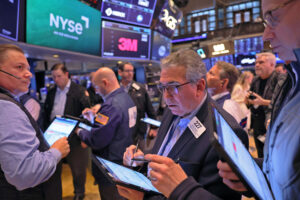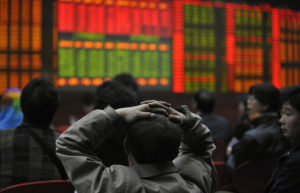This year’s banking crisis was never going to be 2008 redux — more like 2008, the sequel. And while the immediate crisis initially seemed to pass, as JP Morgan CEO Jamie Dimon said in his annual letter to shareholders, the deeper turmoil “is not yet over” and “there will be repercussions from it for years to come”.
In one respect, the collapse of both Silicon Valley Bank and Credit Suisse were isolated, one-off events that have now been contained. Both were badly-run banks ripe for a fall: Credit Suisse because it had squandered investors’ faith; SVB because regulators had let problems fester for a long time. Quick and aggressive actions by both the Swiss and American authorities rapidly staved off crisis. Nevertheless, the runs on these banks are better seen as symptoms of an underlying disease that continues to fester.
Only yesterday, a spooked IMF correctly interpreted SVB and Credit Suisse’s fate as the sign of things to come: the edge of a coming economic storm whipped up by a decade of geopolitical fragmentation and cheap money. Now, the overdue attempt to reverse this course has slowed the global economy, possibly to the point of recession.
Unlike the 2008 crash, this does not follow an era of prosperity, but rather 15 years of monetary chaos. Before 2008, the West had experienced a long period that came to be called The Great Moderation. The neoliberal model, so widely adopted in the post-Cold War era, had substituted fiscal for monetary policy as the prime lever of economic management, diminishing the role of politicians in favour of central banks. Over three decades, a mix of steady growth, short and shallow recessions, rising wealth and tame inflation was lionised by economists as their profession’s triumph; the Nobel Laureate Robert Lucas declared in 2003 that “the central problem of depression-prevention has been solved”.
Yet ordinary people always saw there was something fishy in this triumphalism. The steady inflation underpinning it actually owed less to clever macroeconomic management than to the return of China and the deeper integration of developing countries into the world economy. Coinciding with this globalisation was the biggest migration in human history, as literally billions of people left their farms for the burgeoning cities of the developing world. This swelled the global labour pool by several orders of magnitude, luring a tide of investment away from the developed countries as firms sought cheap labour. In Western countries, profits boomed but the job market did not.
So when the crash happened in 2008, there was a moment when it seemed the model might come in for profound change. But cheap labour meant cheap money. With inflation kept low by repressed labour costs, central banks were free to flood the markets with money, inflating asset values and thereby creating a wealth effect that boosted demand sufficiently to bring the economy out of recession. Depression was averted, the economy was back on its feet, and the authorities celebrated their triumph.
However, a model in which the rich got richer and everyone else got by was obviously bad for social cohesion, and the decade which followed the crash produced an upsurge of protest, populism and anti-establishment politics on both Right and Left. This political revolt had its financial analogue in Bitcoin, which exploited cheap money policies to produce assets which, by having their supply fixed, could only rise in value. The grassroots financial innovation exposed the central bankers’ strategy as little more than old-fashioned currency debasement.
Not that any of this bothered central banks. For a start, political stability wasn’t in their mandates, so they looked on the wave of protests and violent rhetoric with equanimity. One would have thought that asset-price inflation might at least have come onto their radars since it was baking inflationary pressures into the economy. With the rising cost of assets falling heavily on workers who were trying to buy houses, or businesses that had to pay rising rents, anything which restored the bargaining power of labour would release that pent-up demand. But again, central bankers waved off these concerns.
Unbeknown to them, however, the depressed condition of Western workers was about to change. Around the mid-decade, with the demographic transition underway across most of the developing world, the increase in the global labour supply peaked. The first signs of rising labour costs began showing up in the data of Western countries. The picture which resulted resembled that of the early Seventies, when years of steadily building inflationary pressures were sent into overdrive by the oil shocks. Similarly now, any kind of jump in prices would release the horses of inflation.
That happened during the pandemic. When lockdowns and shipping closures choked off supplies and radically altered people’s demand patterns — suddenly we wanted more takeaways but much less air travel — the resulting imbalances sent prices haywire. Rightly, central bankers assumed that since these effects would be transitory, they would sort themselves out in time. Wrongly, they inferred that meant inflation would settle back down of its own accord, and there was no fundamental need for them to change their monetary policy.
What they had failed to understand was that the altered conditions in labour markets meant that unlike previous inflations, this time workers were in a better position to bargain for pay increases. Across the developed economies, wages shook off their decades-long funk and began rising, and to cope employers had no choice but to raise prices. That wasn’t necessarily a problem for them: workers earning more could afford to keep buying in a cycle that was virtuous for many businesses and workers. But it put a floor under the inflation rate so that even when headline inflation did start coming back down, the underlying “core” inflation held up.
Once this became apparent, central banks had no option but to change tack. Having postponed it so long, by which point inflation was nearing double digits, they were forced to slam the brakes hard, with sharp interest rates and measures to take money out of markets. Following decades of more or less handing money over to fund managers, central banks were now asking for it back. That forced asset-holders to either liquidate some of their portfolios or cut their buying, knocking down asset prices. In the age of social media, word spread fast that some banks no longer had enough assets to redeem everyone’s deposits if they all turned up at the teller’s window. So began the runs which crashed SVB and Credit Suisse.
Central banks now find themselves trapped in a stop-start course of withdrawing money with interest-rate rises, and putting it back at each sign of stress (the IMF even predicts that the West will soon return to rock-bottom interest rates). And this hair-of-the-dog treatment may soften the hangover but only prolong the addiction of the financial system to cheap money. Central bankers insist they have not changed course. The markets, currently acting as if the magic money-tree is back, don’t believe them. As a result, this tug-of-war will probably drag on, complicating both the battle on inflation and any efforts to fix the underlying problems in the economy.
There may yet be a silver lining to this tale of woe, though. Unlike in past crashes, when owners emerged largely intact and workers took the hit, this time, it looks like asset prices will remain under pressure while wages hold up. So far, the fall in real incomes has led everyone to take a plus ça change attitude. But there’s clear evidence that wages are catching up with inflation, and in some countries have already turned positive. Workers matter more now, and central banks will have to go back to the drawing board to factor this into their models. In particular, if core inflation remains sticky, they will have to keep interest rates higher for longer, which will squeeze profits and further depress asset prices. And this will force owners to do the heavy-lifting in the fight against inflation, quite a change from the last few decades.
But for now, central banks are muddling through, with Bitcoin arguably serving as the most reliable indicator of how utterly we have lost faith in them. After rising from its humble origins as a penny trade for computer nerds, at one point in the easy-money cycle it was worth over $60,000. When central banks indicated they were serious about inflation, it crashed. But lately, as they eased up in response to the mini-crisis, Bitcoin’s back on a tear, mocking the claims of central banks that they’re back in control. Where they could once wink at asset-owners and say they had their backs, throwing ever more money at them each time their assets fell in value, they’ll now have to start ghosting them. Unless and until central banks convince everyone they are more committed to bringing down inflation than to protecting asset-values, cryptocurrencies will continue to prosper.
What we’re thus witnessing is the end of a historic era as much as an economic one. If neoliberalism set loose the bankers, egged on by central banks, the coming decades will likely see them finally reined back in. And, in that moment, there is the potential to rebalance the world economy, raising workers’ wages and forcing central banks to pay more attention to social conditions, not just those of the banks.
For now, we’re all keeping a close eye on the central banks for signs of backsliding. Use Bitcoin as an index of our lost faith in the financial system. The higher it rises, the more we are giving up on those we once regarded as sages. And if central bankers ever fall back into their worst habits, things could get ugly. The recessions of the 2010s helped stoke a global populist revolt. Another political crisis will probably follow any mismanagement ahead.
Disclaimer
Some of the posts we share are controversial and we do not necessarily agree with them in the whole extend. Sometimes we agree with the content or part of it but we do not agree with the narration or language. Nevertheless we find them somehow interesting, valuable and/or informative or we share them, because we strongly believe in freedom of speech, free press and journalism. We strongly encourage you to have a critical approach to all the content, do your own research and analysis to build your own opinion.
We would be glad to have your feedback.
Source: UnHerd Read the original article here: https://unherd.com/




